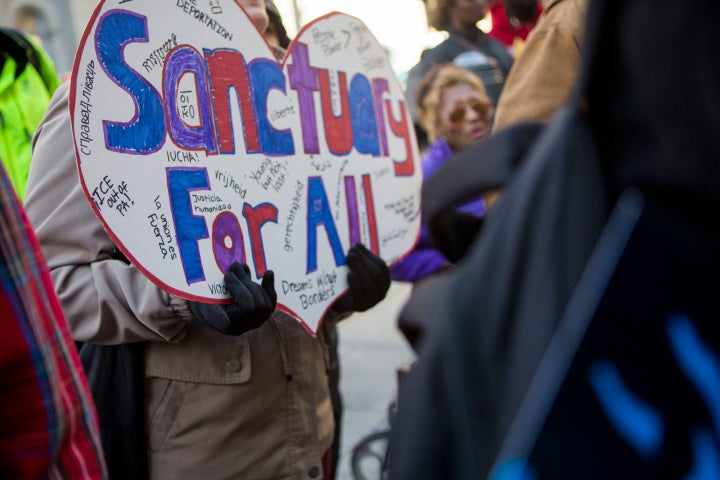
With his announcement of the construction of a border wall with Mexico and an executive order that temporarily suspends the U.S. refugee program, advocates “extreme vetting” of immigrants and bars visas for people from seven majority-Muslim countries, President Donald Trump has stoked flames on both sides of the immigration debate. Should we be surprised by these announcements and the response? Probably not. There is nothing in these announcements that wasn’t central to his presidential campaign and vigorously emotional debate on immigration is as old as our Republic. Does this mean that the administration’s approach is justified? Let’s look at some evidence.
During his gubernatorial run, Governor Phil Scott said that Vermont needs to “to grow the economy by bringing more people here,” adding that this could be achieved through affordable housing, legal immigration and incentives for young workers. In his first briefing on the economy in January, Scott acknowledged that the state’s demographics are a challenge and that population growth is dependent on people moving to the state. The Vermont Chamber of Commerce also released its Futures Project in early January, estimating that there is a gap of nearly 11,000 new workers in the state every year. Last year, Rutland Mayor Chris Louras made it clear that he planned to use the U.S. refugee program to help revitalize his city – one that continues to shrink in population.
Extremely low unemployment, declining population levels and weak tax revenue should encourage all Vermonters to welcome migrants and refugees. So why would there be any wariness? Most skeptics focus on integration, assimilation and security as well as the fiscal costs incurred by small communities. Let’s examine each of these concerns.
In his 2013 book “Exodus” Oxford University professor Paul Collier conducts an exhaustive review of existing literature on the social and economic impacts of migration. He observes: “stripped of the near-overwhelming desire to see it in the light best suited to whatever are one’s moral prejudices, … moderate immigration has predominantly favorable economic effects on the indigenous population, and ambiguous social effects.” In 1910, the “foreign-born” share of the total U.S. population was 14.7 percent and this figure stood at 13.5 percent in 2015, according to the Migration Policy Institute. In recent years, about 1.3 million foreign-born individuals move to the U.S. each year, or about 0.4 percent of the total U.S. population of 324 million people. The leading countries of origin in recent years have been India, China, Mexico, Canada and the Philippines.
Vermont’s population is roughly 625,000 people of which 4 percent – or 25,000 – are foreign-born, far below the U.S. average. Incorporated in this total are the approximately 7,500 refugees the state has absorbed since 1988. Such low numbers suggest that there is significant room to attract more legal migrants to Vermont without exceeding Collier’s notion of “moderate immigration.”
If we accept that small communities can absorb moderate numbers of refugees and migrants without upsetting social order, what about crime and violence? A 2007 study by the National Bureau of Economic Research found that immigrants have much lower incarceration rates than the local-born — on the order of one-fifth the rate of natives (this even holds true second-generation immigrants). This is not to suggest that the foreign-born do not commit crimes – some certainly do – but rather that research indicates they commit fewer crimes than their share of the overall population.
When it comes to terrorism, a New America Foundation study notes: “Far from being foreign infiltrators, the large majority of jihadist terrorists in the United States have been American citizens or legal residents.” Joel Day, assistant professor of security and global studies at the University of Massachusetts Lowell, told PolitiFact that empirical evidence shows that “domestic terrorism is carried out by citizens — not immigrants — with right-wing terrorism, racial hate crimes, and the sovereign-citizen movement making up a majority of domestic terrorist incidents.” The Cato Institute concludes in their analysis of immigration and terrorism between 1975 and 2015 that the probability of perishing in a terrorist attack committed by a foreigner on U.S. soil is 1 in 3.6 million. The study further notes that the chance of being murdered in a terrorist attack caused by a refugee is one in 3.64 billion. The Economist magazine suggests that you are more likely to be killed by “cows, fireworks and malfunctioning elevators than an immigrant terrorist.” Despite this, President Trump has proposed “extreme vetting” for refugees and migrants. But such careful scrutiny – certainly for refugees – already takes place. For five years in the 1990s I worked with the U.S. refugee program and can state without hesitation that the screening process was extremely rigorous, even way back then. With respect to Syrian refugees in particular, this process currently takes between 18 and 24 months and Syrians are the “single most heavily screened and vetted” refugee population in the world, according to the United Nations High Commissioner for Refugees.
If social order and safety can be largely assured, what about the costs – particularly for refugees? When it comes to resettlement, there are certainly upfront costs related to temporary housing, skills training and job placement. But beyond these initial costs, there is little evidence that refugees place a long-term burden on their host economy. Michael Clemens of the Center for Global Development told the Washington Post, “there’s not any credible research that I know of that in the medium and long term that refugees are anything but a hugely profitable investment.” Other migrants are also making significant contributions. A 2012 study by the Immigrant Learning Center notes that migrants have started thousands of science and technology businesses that are “quietly creating almost half a million jobs for Americans and generating revenue of more than $50 billion.”
From this, we can conclude that migration is on balance very positive for Vermont. This is why President Trump’s executive order is so misguided. Rather than employing an ad hoc approach of bans and executive orders, what is needed now is comprehensive reform of U.S. immigration policy, including a clear path for the 11 million undocumented immigrants in the country today. In fact, the “Gang of Eight” made such a proposal in an immigration bill that passed the Senate 68-32 in 2013. Sadly, the bill languishes in the House and has never come up for a vote.
While there are strong economic and social arguments against any ban on classes of migrants, perhaps the strongest is a moral one. We’re a country whose foundations are built on immigration and the principles of racial and religious tolerance. In his 1790 “Letter to the Hebrew Congregation of Newport,” George Washington states that the U.S. government “gives to bigotry no sanction, to persecution no assistance.” In 2015, Barack Obama compared modern-day refugees to the Pilgrims: “Nearly four centuries after the Mayflower set sail, the world is still full of pilgrims – men and women who want nothing more than the chance for a safer, better future for themselves and their families. … What makes America America is that we offer that chance.” Even the half-century old Immigration and Nationality Act of 1965 banned discrimination of immigrants based on their country of origin. These moral arguments are why so many people are protesting the ban.
Vermont clearly needs more migration in the coming years and we can’t just cherry-pick migrants from one country or another. Migrants must want to come to the U.S. and must want to come to our state. They need to feel welcome. Just like the more than 12 million migrants who passed through Ellis Island between 1892 and 1954, welcomed by Emma Lazarus’ poem on a plaque affixed to the base of the the Statue of Liberty:
Give me your tired, your poor, Your huddled masses yearning to breathe free, The wretched refuse of your teeming shore. Send these, the homeless, tempest-tost to me, I lift my lamp beside the golden door!
That lamp is still lit and that door must remain open. They need it, our country needs it and Vermont needs it too.
Stephen Groff grew up in Vermont and has spent the last 30 years working on sustainable development issues around the world. He is vice president of the Asian Development Bank (ADB) in Manila, Philippines. The views expressed in this commentary are his and do not necessarily reflect ADB policy. This commentary first appeared in VTDigger.
Please join him on Facebook and follow him on Twitter (@spgroff).
